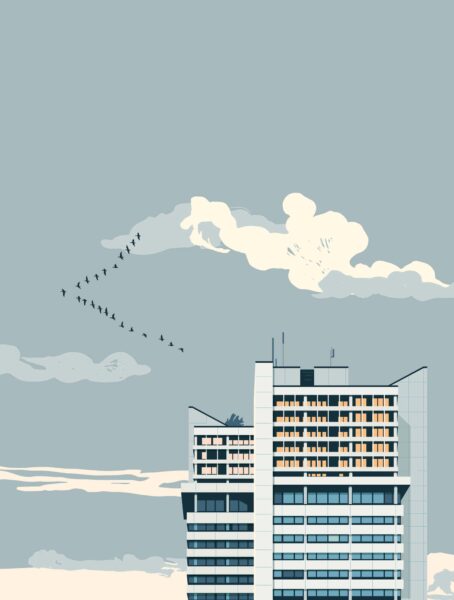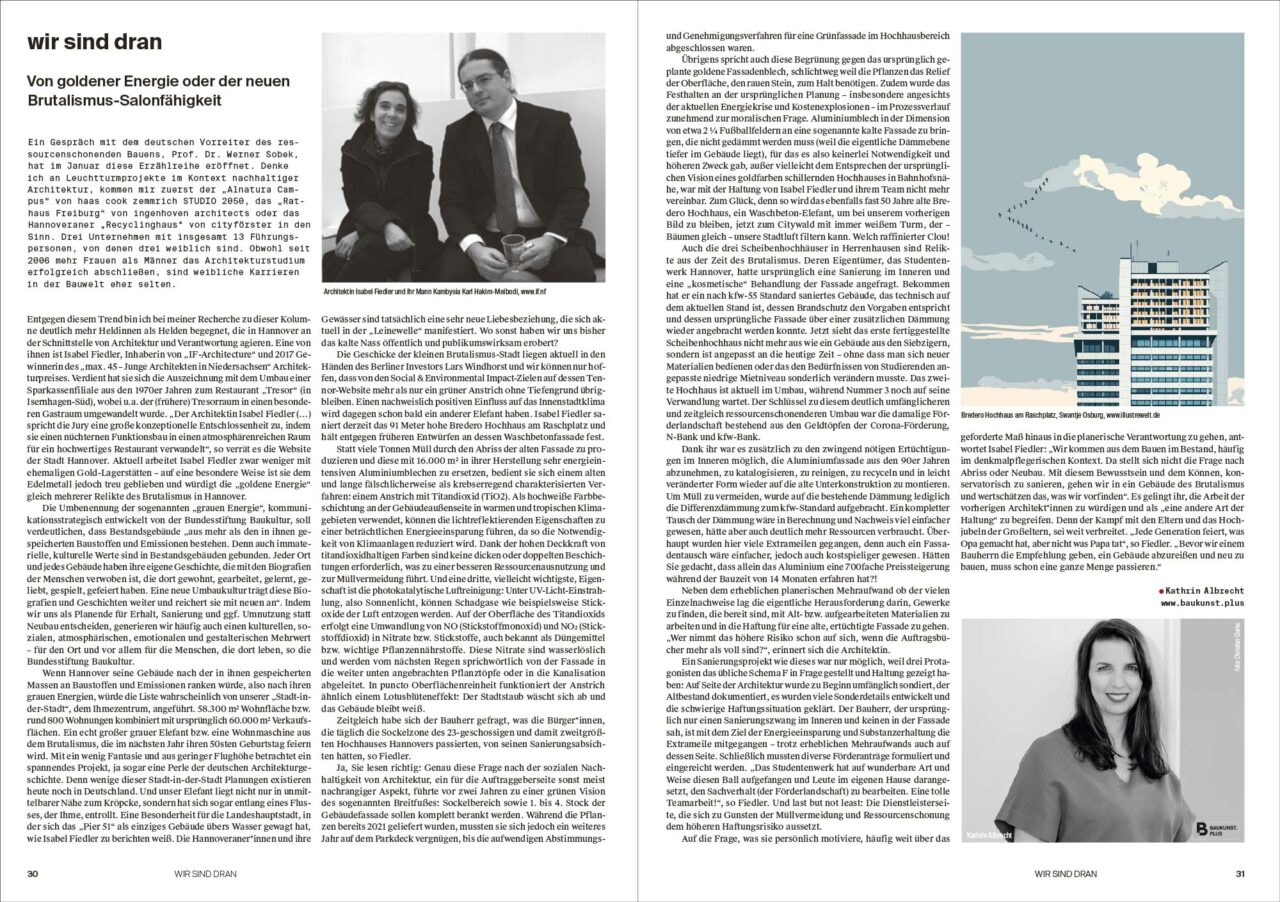
it’s our turn #2
Of golden energy or the new Brutalism salon skill
A conversation with the German pioneer of resource-efficient building, Prof. Dr. Werner Sobek, opened this series of stories in January. When I think of lighthouse projects in the context of sustainable architecture, the “Alnatura Campus” by haas cook zemmrich STUDIO 2050, the “Freiburg City Hall” by ingenhoven architects or the Hanover “Recyclinghaus” by cityförster come to mind first. Three companies with a total of 13 leaders, three of whom are female. Although more women than men have successfully completed their studies in architecture since 2006, female careers in the construction world are rather rare.
Contrary to this trend, during my research for this column I encountered significantly more heroines than heroes who operate at the interface of architecture and responsibility in Hanover. One of them is Isabel Fiedler, owner of “IF-Architecture” and 2017 winner of the “max. 45 – Young Architects in Lower Saxony” architecture award. She earned the award with the conversion of a savings bank branch from the 1970s into the restaurant “Tresor” (in Isernhagen-Süd), whereby, among other things, the (former) vault was transformed into a special guest room. “The jury credits architect Isabel Fiedler (…) with great conceptual determination in transforming a sober functional building into an atmospheric space for a high-quality restaurant,” the Hanover website reveals. Currently, Isabel Fiedler works less with former gold deposits – but in a special way she has remained true to the precious metal and pays tribute to the “golden energy” of several relics of Brutalism in Hanover at once.
The renaming of the so-called “grey energy”, developed in terms of communication strategy by the Bundesstiftung Baukultur (Federal Foundation for Building Culture), is intended to make clear that existing buildings “consist of more than the building materials and emissions stored in them. Because immaterial, cultural values are also bound up in existing buildings. Every place and every building has its own history, which is interwoven with the biographies of the people who lived, worked, learned, loved, played and celebrated there. A new culture of conversion carries these biographies and stories forward and enriches them with new ones.” By choosing preservation, renovation and, if necessary, conversion instead of new construction, we as planners often generate cultural, social, atmospheric, emotional and design added value – for the place and above all for the people who live there, according to the Federal Foundation for Building Culture.

If Hannover were to rank its buildings according to the masses of building materials and emissions stored in them, i.e. according to their grey energies, the list would probably be headed by our “city-within-a-city”, the Ihmezentrum. 58,300 m2 of living space or about 800 flats combined with originally 60,000 m2 of retail space. A really big grey elephant, or rather a residential machine from Brutalism, which will celebrate its 50th birthday next year. With a little imagination and viewed from a low altitude, it is an exciting project, even a pearl of German architectural history. For few of these city-within-a-city plans still exist in Germany today. And our elephant is not only located in the immediate vicinity of Kröpcke, but has even unrolled along a river, the Ihme. A special feature for the state capital, where “Pier 51” is the only building that has ventured across the water, as Isabel Fiedler reports. The people of Hanover and their waters are indeed a very new love affair, which is currently manifesting itself in the “Leinewelle”. Where else have we conquered the cold water in public and with publicity?
The fate of this small Brutalist city is currently in the hands of Berlin-based investor Lars Windhorst, and we can only hope that the Social & Environmental Impact goals on his Tennor website will be more than just a coat of green paint without a deep foundation. On the other hand, another elephant will soon have a demonstrably positive influence on the inner city climate. Isabel Fiedler is currently renovating the 91-metre-high Bredero skyscraper on Raschplatz and, contrary to earlier designs, is sticking to its exposed aggregate concrete façade.
Instead of producing many tonnes of waste by demolishing the old façade and replacing it with 16,000 m2 of aluminium sheeting, which is very energy-intensive in its production, it uses an old and long mistakenly characterised as carcinogenic process: a coating of titanium dioxide (TiO2). Used as a bright white paint coating on building exteriors in warm and tropical climates, its light-reflecting properties can lead to significant energy savings by re- ducing the need for air conditioning. Thanks to the high opacity of titanium dioxide paints, no thick or double coatings are required, leading to better resource utilisation and waste reduction. And a third, perhaps most important, property is photocatalytic air purification: Under UV light irradiation, i.e. sunlight, harmful gases such as nitrogen oxides can be extracted from the air. On the surface of the titanium dioxide, NO (nitrogen monoxide) and NO2 (nitrogen dioxide) are converted into nitrates or nitrogen substances, also known as fertilisers or important plant nutrients. These nitrates are water-soluble and are literally drained off the façade by the next rainfall into the plant pots further down or into the sewage system. In terms of surface purity, the coating works like a lotus blossom effect: the city dust washes off and the building remains white.

At the same time, Fiedler says, the developer asked himself what the citizens who pass through the base zone of the 23-storey high-rise – the second largest in Hannover – think of his renovation plans.
Yes, you read correctly: it was precisely this question of the social sustainability of architecture, an aspect that is usually of secondary importance to the client, that led two years ago to a green vision of the so-called Breitfuß: the plinth area and the 1st to 4th floors of the building’s façade are to be completely covered with vegetation. While the plants were already delivered in 2021, they had to spend another year on the parking deck until the complex coordination and approval procedures for a green façade in the high-rise area were completed.
Incidentally, this greening also speaks against the originally planned golden façade sheet, simply because the plants need the relief of the surface, the rough stone, for support. Moreover, in the course of the process, the conformity of the original planning – especially in view of the current energy crisis and cost explosions – increasingly became a moral question. Putting aluminium sheeting the size of about 2¼ football fields on a so-called cold façade that does not need to be insulated (because the actual insulation level lies deeper in the building), for which there was no need and no higher purpose, except perhaps to contradict the original vision of a shimmering gold-coloured high-rise near the station, was no longer compatible with the attitude of Isabel Fiedler and her team. Fortunately, because the Bredero high-rise, also almost 50 years old, an exposed aggregate concrete elephant to stay with our previous image, now becomes a city forest with an ever-white tower that – like trees – can filter our city air. What a clever trick!
The three high-rise glass buildings in Herrenhausen are also relics from the Brutalist period. Their owner, the Hanover Student Union, originally asked for a refurbishment of the interior and a “cosmetic” treatment of the façade. What he got was a building renovated to kfw-55 standards that is technically up to date, whose fire protection meets the specifications and whose original façade could be reattached over additional insulation. Now the first completed high-rise building no longer looks like a building from the seventies, but has been adapted to modern times – without having to use new materials or make any major changes to the low rent level, which is adapted to the needs of students. The second high-rise is currently under reconstruction, while number 3 is still waiting to be transformed. The key to this much more extensive and at the same time resource-saving conversion was the funding landscape at the time consisting of the Corona funding, N-Bank and kfw-Bank.
Thanks to them, it was possible, in addition to the urgently needed renovations inside, to remove the aluminium façade from the 1990s, catalogue it, clean it, recycle it and reassemble it on the old substructure in a slightly different form. To avoid waste, only the differential insulation to the kfw standard was applied to the existing insulation. A complete replacement of the insulation would have been much simpler in terms of calculation and verification, but would also have consumed significantly more resources. In general, many extra miles were travelled here, because replacing the façade would also have been simpler, but also more expensive. Would you have thought that the price of aluminium alone increased 700-fold during the construction period of 14 months?!

Apart from the considerable additional planning effort due to the many individual verifications, the real challenge was to find trades that were willing to work with old or reconditioned materials and to assume liability for an old, upgraded façade. “Who would take the higher risk when the order books are more than full?” the architect recalls.
A renovation project like this was only possible because three protagonists challenged the usual pattern and showed attitude: On the architectural side, there was extensive probing at the beginning, the old building was documented, many special details were developed and the difficult liability situation was clarified. The client, who originally only saw a need to renovate the interior and not the façade, went the extra mile with the goal of saving energy and preserving the substance – despite considerable additional work on his part as well. After all, various funding applications had to be formulated and submitted. “The Studentenwerk did a wonderful job of picking up the ball and putting its own people to work on the issue (of funding). A great team effort!”, says Fiedler. And last but not least: the service provider side, which exposes itself to the higher liability risk in favour of waste avoidance and resource conservation.
When asked what motivates her personally to often go far beyond the required level of planning responsibility, Isabel Fiedler answers: “We come from the field of building in existing structures, often in the context of monument preservation. There is no question of demolition or new construction. With this awareness and the ability to renovate conservationally, we go into a Brutalist building and appreciate what we find.” She manages to appreciate the work of the previous architects and to understand it as “another kind of attitude”. Because the struggle with parents and the exaltation of grandparents is widespread. “Every generation celebrates what grandpa did, but not what dad did,” says Fiedler. “A lot has to happen before we recommend that a developer demolish a building and build anew.”
Kathrin Albrecht im Stadtkind 2/23
Illustration Bredero high-rise building: Swantje Osburg, www.illustrewelt.de
Photo: Kathrin Albrecht